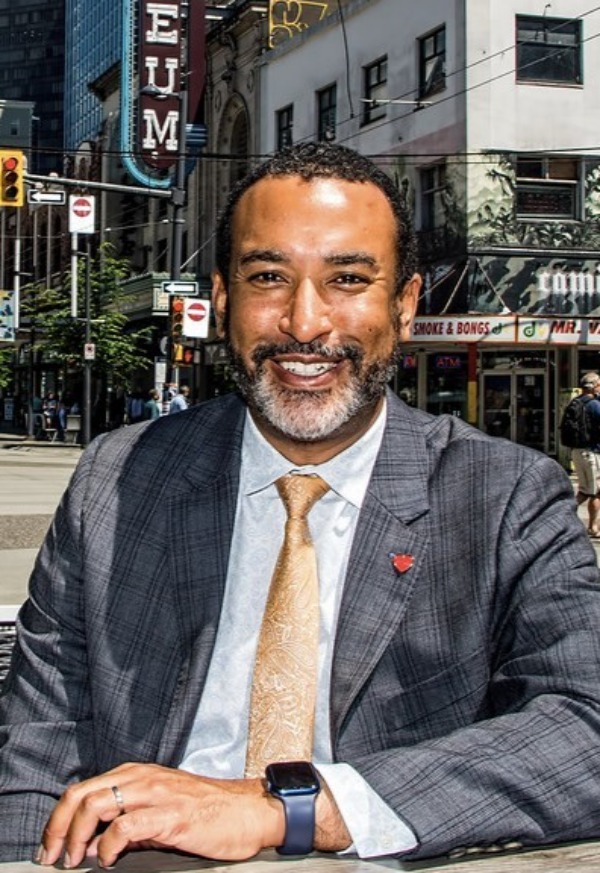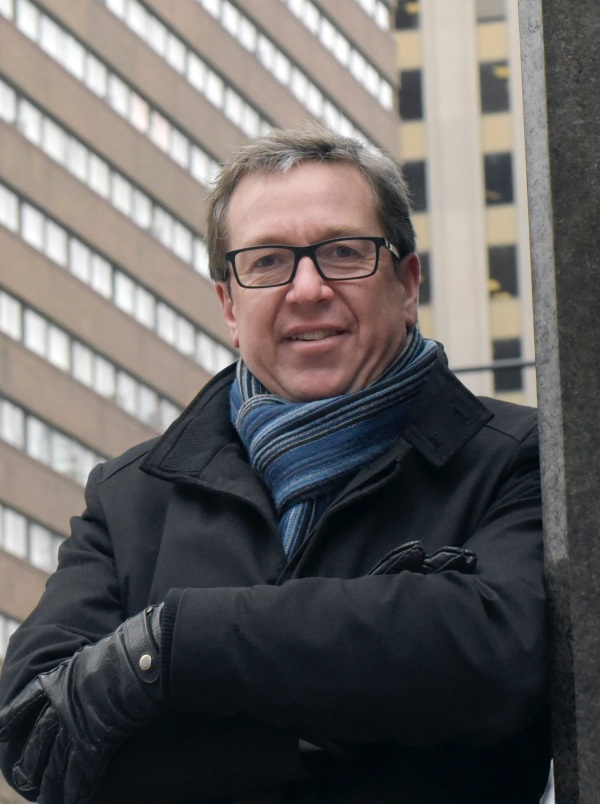Featured Guest
You’ll find this guest among our growing roll of Urban Champions.
-

Puneeta McBryan
Executive Director, Edmonton Downtown Business Association
-

Paul MacKinnon
CEO, Downtown Halifax Business Commission
-

Nolan Marshall
President & CEO, Downtown Vancouver Business Improvement Association
-

Mark Garner
ED, Downtown Yonge BIA
5 Key Takeaways
A roundup of the most compelling ideas, themes and quotes from this candid conversation
1. We have an opportunity to rethink our downtowns
Jennifer Barrett is CUI’s Senior Planner and author of The Case for the Core report. Downtowns are iconic symbols of urban life and belonging, core to the identities and economies of cities. In the wake of COVID-19, downtowns have become places of great contrast, high anxiety, and uncertain futures. According to Jennifer, urban Canada needs bold action. By making the right choices today, downtowns of the future can be more equitable, vibrant, flexible, livable, and resilient.
2. Downtowns as spaces of contention
Vulnerable populations will continue to be drawn to downtowns to receive supports unavailable elsewhere. The multifaceted opioid, homelessness, and pandemic crises have made street-involved people highly visible. Two panelists acknowledged that while their cities have been successful in harm reduction for injection drug users, they have lacked in areas of public education, treatment, and meaningful enforcement. Canada’s downtowns are facing similar problems as evidenced by forceful, high-profile encampment evictions across the country. There is a need for downtowns to learn from each other to avoid making the same mistakes and to properly manage conflicting uses of space.
3. The federal government has the cash, the provinces have the jurisdiction, the cities face the problem
Municipal governments and business organizations must face the brunt of urban issues. But due to jurisdictional constraints, cities are ill-equipped to tackle these social problems. Paul MacKinnon, CEO of Downtown Halifax Business Commission, calls for the need to break down jurisdictional silos and boldly calls for the creation of a national downtown summit. The funding models municipalities rely upon are lacking and must be reconsidered to better provide services and improve the vitality of downtown cores.
4. BIA 2.0
Business improvement districts and downtown development organizations have existed in North America for 80 years and they need to evolve. Innovative BIA practices go beyond the needs of businesses by considering the health of the wider community. In downtown Halifax, the business community funds a social worker, as part of its navigator program, whose main role is to engage with street-involved individuals directing them into services and checking up on them daily. According to Mark Garner, Executive Director of Downtown Yonge BIA, “If you’re not waking up every morning and doing good work to change the neighbourhood that you live in, then you need to start doing it.”
5. Urbanites must recommit themselves to living in a diverse environment
The role of downtown as a gathering place for diverse peoples can serve as a means for cross-cultural and cross-socioeconomic connections. The vitality of Canada’s downtown cores hinges upon inclusivity. Nolan Marshall, CEO of the Downtown Vancouver BIA, calls for better communication strategies that promote diversity and equity. “It’s not just about gathering people from different backgrounds, race, culture, and a place. It’s about giving them a real equity ownership stake in that. And I think that’s going to be transformative to our downtowns going forward.”
Full Panel
Transcript
Note to readers: This video session was transcribed using auto-transcribing software. Manual editing was undertaken in an effort to improve readability and clarity. Questions or concerns with the transcription can be directed to events@canurb.org with “transcription” in the subject line.
Full Audience
Chatroom Transcript
Note to reader: Chat comments have been edited for ease of readability. The text has not been edited for spelling or grammar. For questions or concerns, please contact events@canurb.org with “Chat Comments” in the subject lin
From Canadian Urban Institute: You can find transcripts and recordings of today’s and all our webinars at https://canurb.org/citytalk
12:01:53 From Canadian Urban Institute : Welcome! Folks, please change your chat settings to “everyone” so everyone can see your comments. Attendees: where are you tuning in from today?
12:02:28 From Laurel Davies Snyder : Hello! tuning in from Stratford, Ontario.
12:03:10 From Debbie Chapman : Here from Kitchener, Ontario.
12:03:16 From Andy Fillmore : Hello from Halifax. Nice to back with you!
12:03:20 From Ian O’Donnell to Hosts and panelists : Good morning from Canmore, Alberta
12:03:48 From Joni Carroll : Calgary Arts Development
12:04:32 From Scott Cluney : Greetings from Downtown St. John
12:05:51 From Scott Cluney : Downtown St. John’s. Greetings all.
12:08:31 From Canadian Urban Institute : This week CUI released the Case for the Core report, which will be referenced in today’s conversation. You can read it here: https://canurb.org/publications/case-for-the-core/
12:10:16 From Mary W Rowe to Andy Fillmore and all panelists : can we do a call this week some time?
12:11:20 From Cole Judge : Greetings, Canada, from Downtown Los Angeles!
12:11:22 From Canadian Urban Institute : Jennifer Barrett https://www.linkedin.com/in/jennifer-barrett-a658993/ Jennifer Barrett is a Senior Planner with the Canadian Urban Institute. Jennifer’s diverse experience in the U.S. and Canada has focused on improving social, environmental and economic sustainability. Jennifer has worked in the public, private and non-profit sectors including affordable housing, land use planning and social development policy creation; land development analysis; community consultation; green industry and economic development initiatives. She strives to improve community engagement to ensure that planning decisions represent the diversity of each community. She has received two awards for her planning work as the co-creator of the winning entry for the Morph My City Competition for neighbourhood design at the 2012 National Infrastructure Summit in Regina, SK and as a member of a design team whose work was published for the Edge as Center urban revitalization competition in Boston, MA.
12:18:25 From Canadian Urban Institute : Puneeta McBryan https://www.linkedin.com/in/puneetasm/ @puneeta00 Puneeta McBryan is the Executive Director at the Edmonton Downtown Business Association, where she is working towards Edmonton’s economic recovery by building creative partnerships and aligning stakeholders around a resilient and future-focused core. Prior to joining the EDBA, she served a diverse mix of private and public sector clients across Alberta as a consultant in marketing & communications and business strategy. Puneeta also led communications teams for political campaigns at the municipal and federal levels and served as Board President of the Advertising Club of Edmonton, before a tiny new human started consuming all her spare time.
12:22:25 From Canadian Urban Institute to Jennifer Barrett(Direct Message) : Hey! Any chance you can keep video on? We’d like you to be a part of the convo. Thanks!
12:23:31 From Jennifer Barrett to Canadian Urban Institute(Direct Message) : Yup. I didn’t want to distract from the panelists.
12:23:55 From Canadian Urban Institute : Nolan Marshall https://www.linkedin.com/in/nolan-marshall-iii-336a21a/ @NolanMarshall Nolan Marshall is the President and CEO of the Downtown Vancouver BIA. Prior to joining the DVBIA he served as the Chief Engagement and Solutions Officer at the New Orleans Business Alliance. He lead cross collaboration between Small Business Growth, Strategic Neighborhood Development, and Industry Attraction and Retention teams, and engagement with public sector partners around the economic opportunities and challenges facing New Orleans. His prior work has included grassroots and grasstops community organizing in public safety and public education policy, place based economic development strategies, and creation and implementation of both macro and micro economic development policies and programs.
12:29:34 From Canadian Urban Institute : Paul MacKinnon https://www.linkedin.com/in/paul-mackinnon-9ba8155/ @downtownpaul Paul MacKinnon has been the CEO of Downtown Halifax Business Commission (DHBC) since 2002. DHBC focuses on advocacy, beautification, marketing and communication, and membership engagement for 1600 member businesses in Eastern Canada’s largest city. He sits on the International Downtown Association (IDA) board as Canada’s ex-officio representative. He is also currently serving as the President of Downtowns Atlantic Canada, and is a member of the IDA Canada leadership network.
12:34:20 From Laurel Davies Snyder : National Downtown Summit – yes 🙂
12:35:52 From Frank Miele : Mary, most downtowns have financial incentives, can your speakers speak to some of the most well used by the investors?
12:37:30 From Canadian Urban Institute : Mark Garner https://www.linkedin.com/in/mark-garner-69a78a5/ @Mark_Downtown Mark Garner has been a successful business and community leader for more than 30 years and is now focusing his expertise and vision on the transformation of one of Toronto’s most vital tourism and business hubs. As Chief Operating Officer and Executive Director for the Downtown Yonge Business Improvement Area, Mark is an active champion for building a thriving, vibrant city centre. His business acumen and social conscience were forged during his years as a senior executive at major Canadian companies, including Bank of Montreal, AT&T and NCR Canada. Prior to joining Downtown Yonge in early 2013, Mark spearheaded economic development in the Kitchener-Waterloo area, including five years as Executive Director of the Downtown Kitchener BIA – a period of tremendous growth and revitalization for Kitchener.
12:37:42 From Canadian Urban Institute : Over the past decade he has increasingly concentrated on the revitalization and development of urban downtowns, playing an integral role as a catalyst for targeted economic growth, vibrant neighbourhoods, social innovation and start-up incubators. An action-oriented advocate for change, Mark has spearheaded numerous campaigns and projects to bring about improvements – including executing programs to clean up laneways, developing and implementing a comprehensive Music Strategy, and working directly with municipal leaders on urban planning and revitalization.
12:48:40 From Art Eggleton : The pandemic has resulted in a substantial reduction in public transit usage. Even though many are still working from home, the streets of Toronto’s core and surrounding areas are frequently clogged with automobile traffic because many are concerned about safety in using public transit. How and when can we restore confidence for a return to more public transit usage which is vital to the vibrancy of downtown? Art Eggleton
12:51:56 From Lars Henriksson : Give the municipalities the right to income tax. In Sweden, municipalities receive the majority of the income tax
12:53:02 From Mark Garner : Art.. this is one of the big issues to resolve. More investment in heavy rail is needed.. more trains, less overcrowding and increased frequency of cleaning are good things to start with. Part of the work that SRRA has done for the CORE BIAs has indicated based on the lack of use of transit when we get back to 30% occupancy in the employment cluster our parking lots will be full
12:53:52 From Paul MacKinnon : Uytae Lee (Vancouver) created a wonderful transit YouTube video on transit. I’ll see if I can post the link.
12:54:34 From Michael Roschlau : @Art – good points. Transit systems are rolling out various initiatives, including continued mask use, deep cleaning and installation of copper coatings to eliminate germs and virus spread. Check out the latest TTC video https://www.youtube.com/watch?v=roAAxJBgnSE but it is a BIG challenge.
12:54:41 From Paul MacKinnon : https://www.bing.com/videos/search?q=uytae+lee+transit+youtube&docid=608003739598934822&mid=BCA2F2BB062E8C7779FEBCA2F2BB062E8C7779FE&view=detail&FORM=VIRE
12:58:00 From Paul MacKinnon : Action item for all: share the report (especially pg.51) with your mayor, MLA/MPP, MP.
12:58:26 From Art Eggleton : Good that there are videos attempting to get people back to public transit but much more promotion is needed because it isn’t registering with enough people. Art Eggleton
12:59:44 From Mark Garner : all 3 levels of government need to work together in ways they have never worked before
13:01:10 From Canadian Urban Institute : Keep the conversation going #citytalk @canurb You can find transcripts and recordings of today’s and all our sessions at https://www.canurb.org/citytalk Read the Case for the Core report here: https://canurb.org/publications/case-for-the-core/ CUI extends a big thank you to TD for their support on CityTalk. COMING UP: Join us on Thursday October 7 for our next session “Creating vibrant main streets: What will it take?”. You can register here: https://us02web.zoom.us/webinar/register/WN_k5zMZFckSde__09d219MOg
13:01:44 From Debbie Chapman : Thank you for the interesting discussion. Good to see you Mark.
13:02:41 From Ralph Cipolla to Hosts and panelists : Thank you from Orillia ontario
13:02:43 From Loredana Wainwright to Hosts and panelists : Great discussion!! Thank you!
13:03:00 From Mark Garner : Thank you CUI for the work you do
13:03:20 From Ian O’Donnell : Thank you
13:03:48 From Frank Miele : thank you Mary



